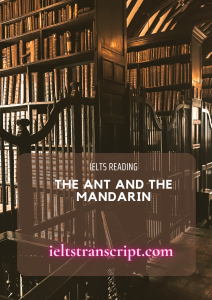- Đối với sản phẩm có giá: Sau khi chúng tôi ghi nhận thông tin đã thanh toán sản phẩm của bạn, sản phẩm sẽ được mở khóa và bạn có thể xem trực tiếp và tải tài liệu sản phẩm.
- Đối với thành viên trả phí: Bạn có thể mua và thanh toán sản phẩm với giá 0đ để tải tài liệu sản phẩm.
- Bạn có thể liên hệ với chúng tôi để được hỗ trợ mở khóa sản phẩm sớm nhất.
The Ant and the Mandarin
- Chúng tôi chấp nhận các phương thức thanh toán sau đây: Thẻ tín dụng, thẻ ghi nợ, PayPal, chuyển khoản ngân hàng và tiền mặt.
Chúng tôi sẽ không thu thêm phí cho bất kỳ hình thức thanh toán nào.
- Nếu bạn gặp vấn đề về sản phẩm của chúng tôi trong thời gian sử dụng, vui lòng liên hệ với chúng tôi để được hỗ trợ xử lý sớm nhất nhé.
Xem trước mẫu
The Ant and the Mandarin
In 1476, the farmers of Berne in Switzerland decided there was only one way to rid their fields of the cutworms attacking their crops. They took the pests to court. The worms were tried, found guilty and excommunicated by the archbishop. In China, farmers had a more practical approach to pest control. Rather than relying on divine intervention, they put their faith in frogs, ducks and ants. Frogs and ducks were encouraged to snap up the pests in the paddies and the occasional plague of locusts. But the notion of biological control began with an ant. More specifically, it started with the predatory yellow citrus ant Oeco-phylla smaragdina, which has been polishing off pests in the orange groves of southern China for at least 1,700 years. The yellow citrus ant is a type of weaver ant, which binds leaves and twigs with silk to form a neat, tent-like nest. In the beginning, farmers made do with the odd ants’ nests here and there. But it wasn’t long before growing demand led to the development of a thriving trade in nests and a new type of agriculture – ant farming.
For an insect that bites, the yellow citrus ant is remarkably popular. Even by ant standards, Oecophylla smaragdina is a fearsome predator. It’s big, runs fast and has a powerful nip – painful to humans but lethal to many of the insects that plague the orange groves of Guangdong and Guangxi in southern China. And for at least 17 centuries, Chinese orange growers have harnessed these six-legged killing machines to keep their fruit groves healthy and productive.
Citrus fruits evolved in the Far East and the Chinese discovered the delights of their flesh early on. As the ancestral home of oranges, lemons and pomelos, China also has the greatest diversity of citrus pests. And the trees that produce the sweetest fruits, the mandarins – or kan – attract a host of plant-eating insects, from black ants and sap-sucking mealy bugs to leaf-devouring caterpillars. With so many enemies, fruit growers clearly had to have some way of protecting their orchards.
The West did not discover the Chinese orange growers’ secret weapon until 1 the early 20th century. At the time, Florida was suffering an epidemic of citrus canker and in 1915 Walter Swingle, a plant physiologist working for the US f Department of Agriculture, was sent to China in search of varieties of orange that were resistant to the disease. Swingle spent some time studying the citrus orchards around Guangzhou, and there he came across the story of the cultivated ant. These ants, he was told, were “grown” by the people of a small village nearby who sold them to the orange growers by the nestful.
The earliest report of citrus ants at work among the orange trees appeared in a book on tropical and subtropical botany written by Hsi Han in AD 304. “The people of Chiao-Chih sell in their markets ants in bags of rush matting. The nests are like silk. The bags are all attached to twigs and leaves which, with the ants inside the nests, are for sale. The ants are reddish-yellow in colour, bigger than ordinary ants. In the south, if the kan trees do not have this kind of ant, the fruits will all be damaged by many harmful insects, and not a single fruit will be perfect.”
Initially, farmers relied on nests which they collected from the wild or bought in the market where trade in nests was brisk. “It is said that in the south orange trees which are free of ants will have wormy fruits. Therefore, people race to buy nests for their orange trees,” wrote Liu Hsun in Strange Things Noted in the South in about 890.
The business quickly became more sophisticated. From the 10th century, country people began to trap ants in artificial nests baited with fat. “Fruit-growing families buy these ants from vendors who make a business of collecting and selling such creatures,” wrote Chuang Chi-Yu in 1130. “They trap them by filling hogs’ or sheep’s bladders with fat and placing them with the cavities open next to the ants’
...Con kiến và cây quýt
Vào năm 1476, những người nông dân ở Berne, Thụy Sĩ quyết định chỉ có một cách để khử những con sâu ngài đêm tấn công mùa màng ra khỏi những cánh đồng của họ khỏi. Họ đã đưa những kẻ gây hại ra tòa. Những con sâu đã bị tổng giám mục xét xử, bị kết tội và bị vạ tuyệt thông. Ở Trung Quốc, nông dân đã có cách tiếp cận thực tế hơn để kiểm soát dịch hại. Thay vì dựa vào sự can thiệp của thần thánh, họ đặt niềm tin vào ếch, vịt và kiến. Ếch và vịt được khuyến khích bắt sâu bọ trên đồng ruộng và nạn châu châu. Nhưng khái niệm kiểm soát sinh học bắt đầu từ kiến. Cụ thể hơn, nó bắt đầu từ loài kiến vàng ăn thịt sống trên cây có múi Oeco-phylla smaragdina, đã diệt trừ các loài gây hại trên các vườn cam ở miền nam Trung Quốc trong ít nhất 1.700 năm. Kiến vàng này là một loại kiến thợ dệt, chúng dùng tơ để kết lá cây và các cành nhỏ lại làm thành tổ gọn gàng giống như cái lều. Ban đầu, những người nông dân thường làm tổ kiến nhỏ lẻ ở một vài nơi. Nhưng chẳng bao lâu nhu cầu ngày càng tăng đã dẫn đến sự phát triển mạnh mẽ của việc buôn bán tổ kiến và một loại hình nông nghiệp mới – nuôi kiến.
Trong các côn trùng cắn, kiến vàng rất phổ biến. Ngay cả theo tiêu chuẩn về kiến, Oecophylla smaragdina là một kẻ săn mồi đáng sợ. Nó to lớn, chạy nhanh và có vòi rất khỏe – gây đau đớn cho con người nhưng lại có thể giết chết nhiều loài côn trùng gây hại cho các vườn cam ở Quảng Đông và Quảng Tây miền nam Trung Quốc. Và trong ít nhất là 17 thế kỷ, người trồng cam Trung Quốc đã khai thác những cỗ máy tiêu diệt sâu bọ sáu chân này để giữ cho vườn trái cây của họ khỏe mạnh và năng suất
Trái cây họ cam quýt đã phát triển ở Viễn Đông và người Trung Quốc đã sớm khám phá ra sự tuyệt diệu từ cơm của chúng. Là quê hương tổ tiên của cam, chanh và bưởi, các loài gây hại trên cây có múi ở Trung Quốc cũng đa dạng nhất. Và những cây cho quả ngọt nhất, quýt – hay kan – thu hút hàng loạt các loài côn trùng ăn thực vật, từ kiến đen, rệp sáp hút nhựa cây đến sâu bướm ăn lá. Với rất nhiều kẻ thù, người trồng cây rõ ràng phải có một số cách để bảo vệ vườn cây ăn trái của họ.
Phương Tây đã không phát hiện ra vũ khí bí mật của người trồng cam Trung Quốc cho đến tận đầu thế kỷ 20. Vào thời điểm đó, Florida đang bị dịch bệnh thối rữa trên cây có múi và vào năm 1915, Walter Swingle, một nhà sinh lý học thực vật làm việc cho Bộ Nông nghiệp Hoa Kỳ, được cử đến Trung Quốc để tìm kiếm các giống cam có khả năng chống lại bệnh này. Swingle đã dành thời gian nghiên cứu các vườn cây ăn quả có múi ở Quảng Châu, và ở đó ông tình cờ nghe câu chuyện về loài kiến trồng trọt. Theo ông, những con kiến này được “nuôi” bởi người dân của một ngôi làng nhỏ gần đó, những người này đã bán chúng cho những người trồng cam.
Báo cáo sớm nhất về loài kiến vàng hoạt động trên các cây cam xuất hiện trong một cuốn sách về thực vật học nhiệt đới và cận nhiệt đới do Hsi Han viết vào năm 304 sau công nguyên. “Người dân Chiao-Chih bán kiến trong túi cói. Những cái tổ giống như tơ. Các túi đều gắn cành cây, lá cây, có kiến bên trong. Kiến vàng đỏ, to hơn kiến thường. Ở miền Nam nếu các cây kan không có loại kiến này, quả nào cũng bị nhiều côn trùng gây hại phá hoại, không một quả nào là hoàn hảo cả”.
Ban đầu, những người nông dân dựa vào tổ kiến mà họ thu thập được từ tự nhiên hoặc mua ở thị trường nơi việc buôn bán kiến đang phát triển mạnh. “Người ta nói rằng những cây cam miền nam không có kiến sẽ có trái bị sâu. Vì vậy, mọi người đua nhau mua tổ kiến cho cây cam của họ”, Liu Hsun viết trong tạp chí Strange Things Noted in the South vào khoảng năm 890.
Việc kinh doanh nhanh chóng trở nên tinh vi hơn. Từ thế kỷ thứ 10, những người ở nông thôn bắt đầu bẫy kiến trong các tổ nhân tạo có mỡ. Chuang Chi-Yu viết vào năm 1130: “Các gia đình trồng cây ăn quả mua những con kiến này từ những người bán hàng, những người làm công việc kinh doanh thu thập và bán những sinh vật đó. Họ bẫy kiến bằng cách đổ đầy mỡ vào bong bóng lợn hoặc cừu và đặt chúng vào các lỗ mở
...Để xem được đầy đủ nội dung và tải dữ liệu, bạn phải trở thành thành viên của chúng tôi và trả phí cho tài liệu (nếu có)











